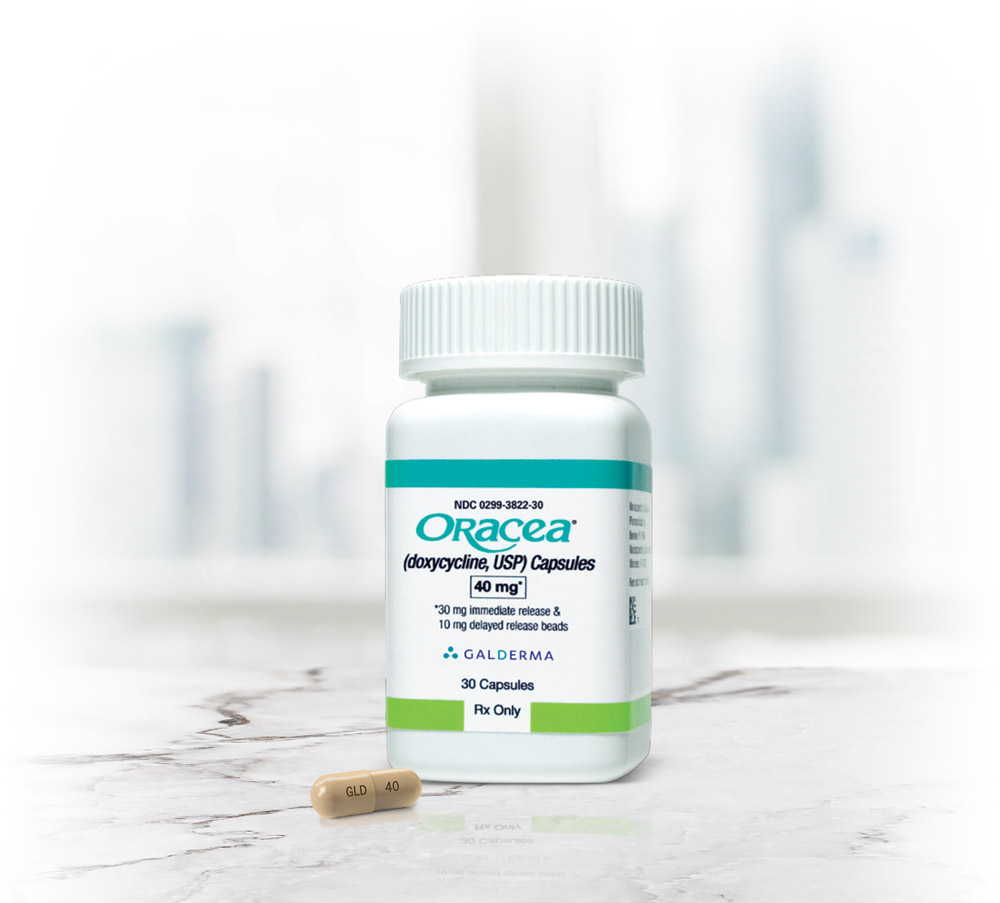ORACEA

Oracea is one of the brand names for the drug doxycycline (along with Adoxa, Alodox, Avidoxy, Doryx, Monodox, Oraxyl, Periostat, and Vibramycin) but is made by Galderma and is specifically for treatment of rosacea. (1) Oracea is in the family of tetracycline antibiotics that are often used to treat infections (such as acne). However, this formulation has not been evaluated in the treatment or prevention of infections and is used only to treat the inflammatory bumps and pimple-like blemishes caused by rosacea in adults. (1)
Oracea is prescribed by dermatologists, and is taken in pill form. Lower doses of doxycycline (like that contained in Oracea, a single pill that contains 30 mg immediate release plus 10 mg delayed release) might cause less antibiotic resistance and still be effective in treatment of rosacea. (2) Additionally, after four weeks of good control of the rosacea, often the medication can be gradually tapered down over the next four weeks to the minimum that will control the disease. However, long-term therapy may be required. (2)
About Rosacea
Rosacea is a type of acne-like inflammatory condition primarily of middle-aged and older adults (usually ages 30-60) characterized by vascular dilation and redness/flushing of the central face (nose, cheek, eyelids, and forehead). The cause of vascular dilatation in rosacea is unknown, although factors that trigger innate immune responses may worsen symptoms and there is some evidence that hair follicle mites and bacterial overgrowth in the GI tract may contribute to the disease. (2) Rosacea is not a bacterial infection, and the disease is chronic and control rather than cure is the goal of therapy. (2)
Oral antibiotics like Oracea are particularly useful in patients with nodular rosacea, and also are indicated in patients with ocular symptoms (rosacea and inflammation of the eye that will occasionally occur in rosacea patients.) It may take up to six weeks for improvement to occur with topical therapy alone and oral therapy combined with topical medications may be useful initially for control of rosacea, then tapering the oral medication. (2)
Oracea Claims and Uses
The Oracea® (doxycycline, USP) capsule is, according to the website oracea.com, the “only oral therapy approved by the FDA to treat the inflammatory lesions of rosacea. In a study of 966 rosacea patients, 81% were “satisfied” or “very satisfied” with their Oracea® treatment.” (4) Galderma reports that many patients treated with Oracea® in clinical trials started to see reduction in inflammatory lesions after 3-4 weeks and these continued through the full 16-week course of the study. (4) Additionally, because of the lower dose of doxycycline contained in Oracea, in clinical studies, Oracea® has not shown to contribute to antibiotic resistance. (4)
Studies
Several large trials were performed to evaluate Oracea, two phase III clinical trials and a phase IV clinical trial. The largest was a 12-week, community-based study of 1,421 adults with mild, moderate and severe papulopustular rosacea. In this study there was a group that underwent treatment with Oracea® alone (n=1,196). (5) Results of the study showed that 74.6% of participants were clear or near clear of their rosacea by week 12 (n=826), and 74.5% had CEA scores reflecting (IGA) none or mild erythema (redness) after 12 weeks. (5) Side effects were also evaluated. 6.7% had treatment-related adverse events, mostly mild to moderate in severity and included: gastrointestinal tract disorders (4.2%), nausea (1.3%), diarrhea (1.2%), skin and subcutaneous disorders (2.7%), nervous system disorders (1.7%) and headache (1.0%). (5)
Another group of 224 subjects underwent treatment with doxycycline 100 mg in addition to Oracea as treatment for their rosacea. This group had the following results: 75.7% of participants were clear or near clear by week 12, and 63.6% had mild CEA scores. (6) Additionally, 6.8% had treatment-related adverse events, mostly mild or moderate in severity and included: gastrointestinal tract disorders (7.1%), diarrhea (2.7%), nausea (1.8%), skin and subcutaneous disorders (3.1%), rash (1.3%), and nervous system disorders (1.8%). (6)
When they were surveyed, 90.4% of the doctors at community-based investigators reported they were likely or very likely to continue prescribing doxycycline 40 mg (Oracea). 81.3% of participants were satisfied or very satisfied with Oracea® alone and 79.3% of participants were satisfied or very satisfied with Oracea® as add-on therapy. (6)
Side Effects and Warnings
Oracea® does have GI consequences, so it should be taken on an empty stomach 1 hour before or 2 hours after meals. Additionally, common side effects include abdominal distention and pain, anxiety, back pain, fungal infection, hyperglycemia (high blood sugar), influenza, nasal congestion, nasopharyngitis, sinus headache, sinusitis, and xerostomia (dry mouth). (3)
Oracea is categorized by the FDA as pregnancy category D. This means you should not use Oracea if you are pregnant because doxycycline passes into breast milk and may affect bone and tooth development in a nursing baby. (1) If you become pregnant you must stop taking Oracea. Additionally, Oracea can make birth control pills less effective and a non-hormone method of birth control (such as a condom, diaphragm, spermicide) should be used to prevent pregnancy while using Oracea. (1) Children should also not use this medicine because Oracea can cause permanent yellowing or graying of the teeth in children younger than 8 years old. (1)
References:
- Oracea. Accessed May 25, 2011. http://www.drugs.com/oracea.html
- Goldstein, B. Goldstein, A. Rosacea. Accessed May 25, 2011. http://www.uptodate.com/contents/rosacea?source=search_result&selectedTitle=1%7E71#H13
- Why Oracea. 2011 Galderma Laboratories, http://oracea.com/oracea/whyoracea.aspx
- Del Rosso JQ, Webster, GF, Jackson M, et al. Two randomized phase III clinical trials evaluating anti-inflammatory dose doxycycline (40 mg doxycycline, USP capsules) administered once daily for treatment of rosacea. J Am Acad Dermatol. 2007;56(5):791-802.
- Del Rosso JQ, Schlessinger J, Werschler P. Comparison of anti-inflammatory dose doxycycline versus doxycycline 100 mg in the treatment of rosacea. J Drugs Dermatol. 2008;7(6):573-576.


